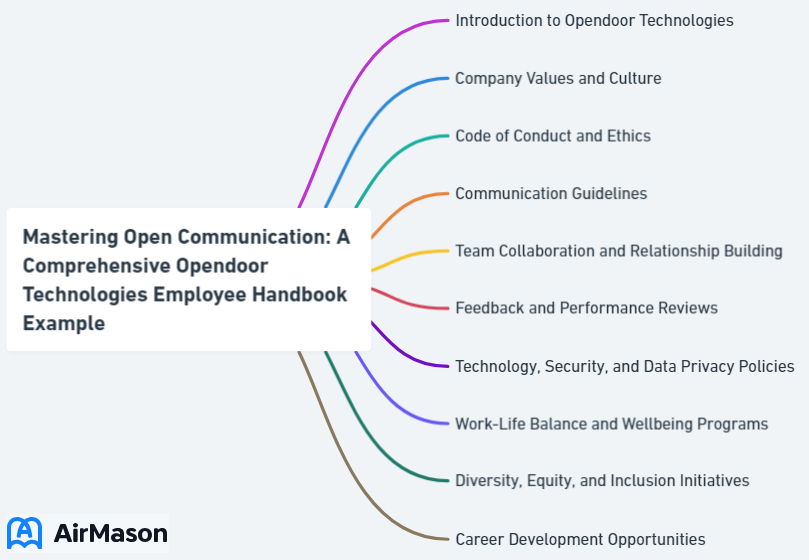
Imagine a workplace where employees can confidently share their ideas, concerns, and feedback with their managers, knowing they will be heard and valued. This vision can become a reality with the implementation of an open door policy. But what does it take to create such a positive work environment? Let’s explore the world of open door policies and discover how they can revolutionize communication and collaboration within an organization, using the Opendoor Technologies Employee Handbook Example as a guide.
Key Takeaways
- Open door policy fosters trust, collaboration and communication in the workplace.
- Implementing an effective open door policy requires managerial accessibility, diverse communication channels and timely issue resolution.
- Training managers & employees on the policies & monitoring/evaluating them regularly is essential for successful implementation of an open door policy.
Fortune 100 Company Employee Handbook
Welcome to the Fortune 100 Company Employee Handbook, a comprehensive guide designed to provide you with essential information about our organization. Within these pages, the “Fortune 100 Company Employee Handbook” serves as your go-to resource for understanding company policies, procedures, and expectations. As you embark on your journey with us, take the time to familiarize yourself with the guidelines outlined in this handbook. It covers everything from workplace conduct to benefits, ensuring a smooth integration into our dynamic and innovative work environment. Your commitment to upholding the principles outlined in the Fortune 100 Company Employee Handbook is instrumental in fostering a positive and collaborative workplace culture.
Understanding Opendoor Technologies
An open door policy is a workplace culture that promotes open communication between employees and their supervisors and peers. Implementing an open door policy comes with several benefits including improved employee engagement, better communication, and the ability to resolve issues before they become critical. However, it’s important to note that not all issues, especially those involving sensitive or classified information, are appropriate for this policy.
Open communication is imperative for a company’s growth and development, contributing to a better work environment. Platforms like BetterUp provide training and resources for leaders to refine their communication abilities, emotional intelligence, and establish robust working relationships. Comprehending the importance of open communication enables organizations to establish and uphold a successful open door policy, benefiting both employees and the organization.
Crafting an Employee Handbook with Open Door Policy Focus
Creating an employee handbook that emphasizes the open door policy is vital in demonstrating the organization’s dedication to transparent and accommodating communication between supervisors and staff members. A well-crafted handbook can help clarify the scope and expectations of an open door policy workplace culture, ensuring that personnel have the capacity to approach someone for guidance or to address operational difficulties.
The following sections will outline how to highlight company values, manage workplace expectations, and promote feedback and idea sharing in an open door policy handbook.

Emphasizing Company Values
An open door policy promotes key values such as:
- Open communication
- Transparency
- Trust
- Employee empowerment
By fostering a culture of collaboration and inclusivity, employees are more likely to express their ideas, concerns, and feedback freely, leading to a more positive work environment. To highlight company values in an open door policy handbook, it is important to include specific examples and situations that align with the organization’s values, aiding employees in understanding how the open door policy supports and strengthens these values.
Transparency plays a vital role in an open door policy, as it encourages open communication, trust, and inclusiveness in the workplace. Promoting increased transparency within the organization allows employees to comfortably express their views, concerns, and suggestions to management. This transparency assists in establishing trust and cultivating a culture of collaboration and productivity, ultimately benefiting the organization as a whole.
Addressing Workplace Expectations
In an open door policy setting, both employees and managers hold distinct roles and responsibilities to uphold open communication. Employees are expected to actively participate in team meetings and discussions, respect confidentiality, and embrace a culture of open communication. Managers, on the other hand, must create a culture of open communication, actively listen to employees’ concerns and feedback, and ensure that employees feel comfortable approaching them with any issues or ideas.
To uphold etiquette in an open door policy, it’s crucial for managers to lead by example, ensuring that discourse is considerate and professional. Establishing boundaries and appreciating people’s time are also essential factors in implementing an open door policy effectively. By managing workplace expectations and promoting open communication, organizations can establish a supportive and inclusive environment where employees feel appreciated and listened to.
Encouraging Feedback and Idea Sharing
Feedback plays a significant role in an open door policy. Every individual has valuable insights to offer, and acknowledging employees as the core of the business can assist in achieving success. To effectively encourage feedback and idea sharing in an open door policy, strategies can be employed such as:
- Actively seeking feedback from employees
- Holding impromptu conversations to create opportunities for open communication
- Focusing on establishing trust and psychological safety
Proactive leadership, support, and employee engagement are essential techniques for stimulating idea sharing in a company with an open door policy. Promoting feedback and idea sharing enables organizations to cultivate a culture where employees feel at ease sharing their thoughts and recommendations for improvement, which in turn benefits the entire organization.
Key Components of an Effective Open Door Policy

An effective open door policy includes key elements such as managerial accessibility, varied communication channels, and prompt issue resolution. These components ensure that employees have multiple avenues to voice their concerns and ideas while feeling confident that their input is valued and addressed.
The following sections will provide a more detailed examination of each of these components and their importance in a successful open door policy.
Managerial Accessibility
Ensuring that managers are approachable and available for open communication with employees is a crucial aspect of an open door policy. To enhance managerial accessibility in a workplace, strategies such as:
- Heightening awareness of DEIA issues among managers and employees
- Offering training and education to improve awareness and understanding of disabilities and accessibility requirements
- Communicating regularly and effectively with employees to guarantee accessibility needs are satisfied
These strategies can help create a more inclusive and accessible work environment.
Technology tools can aid in enhancing managerial accessibility by providing assistive features, enabling remote collaboration, and ensuring inclusive digital content. By prioritizing accessibility, organizations can create an open door policy that caters to the diverse needs of their employees, fostering a culture of open communication and collaboration.
Diverse Communication Channels
Providing multiple channels for employees to express their concerns and ideas is vital in an open door policy. This can include:
- In-person meetings
- Online platforms such as discussion boards
- Virtual communication tools like Microsoft Pulse
Providing varied communication channels gives employees the flexibility to choose the method that best fits their needs and comfort level.
Two-way communication is essential for corporate growth and development, as it allows businesses to:
- Gain information and feedback from various sources, including employees with experience from other organizations
- Make adjustments to increase profitability and optimize internal workflows
- Address employee concerns more effectively
- Establish a more inclusive and supportive work environment
Using varied communication channels can help organizations achieve these goals.
Gap Employee Handbook Example
In the comprehensive Gap Employee Handbook Example, employees gain valuable insights into the company’s policies, procedures, and expectations. This handbook serves as a vital resource, outlining the core values and guiding principles that define the work culture at Gap. From code of conduct to benefits information, the Gap Employee Handbook Example is designed to empower employees with the knowledge they need for a successful and fulfilling career. As a crucial tool for onboarding and ongoing reference, this handbook reflects Gap’s commitment to fostering a positive and inclusive workplace. Explore the Gap Employee Handbook Example to navigate your professional journey within the company seamlessly.
Timely Issue Resolution
Promptly and effectively addressing employee concerns and feedback is key to maintaining trust and engagement in an open door policy. Timely issue resolution prevents problems from intensifying, resulting in a more constructive and beneficial work environment. To address concerns and ensure timely issue resolution, suggested practices include:
- Thoroughly recording each issue
- Promoting open communication
- Attentively listening to employees’ worries
- Structuring the open door policy effectively
- Encouraging prompt reporting of difficulties.
Technology can also assist in expediting the resolution of matters in an open door policy by enabling communication and supplying documentation. By prioritizing timely issue resolution, organizations can demonstrate their commitment to addressing employee concerns and fostering a culture of trust and collaboration.
Implementing the Open Door Policy in the Workplace

Successfully implementing an open door policy in the workplace requires prioritizing open communication methods, handling complaints constructively, and creating a supportive atmosphere. The following sections will discuss the importance of training managers and employees, tracking and assessing the policy, and fostering a culture of trust and collaboration for the successful implementation of an open door policy.
Training Managers and Employees
Providing the necessary training and resources to encourage managers and employees to understand and adhere to the open door policy is essential. Resources such as:
- Employee handbooks
- Training sessions
- Communication channels
- Managerial support
- Frequent reminders
A guide incorporating such a policy can be provided to employees to help them comprehend the open door policy.
Training on the open door policy is pivotal to guarantee that disagreements are reduced and employees are cognizant of the advantages and regulations of the policy. Regular training sessions can assist in guaranteeing that disputes are minimized and employees are cognizant of the advantages and rules of the open door policy.
Monitoring and Evaluating the Policy
Regularly reviewing the effectiveness of the open door policy is important to ensure its success. Here are some steps to follow:
- Actively listen to employee feedback.
- Analyze feedback trends to identify areas for improvement.
- Assess employee satisfaction with the open door policy.
- Monitor the impact of the policy on communication within the organization.
- Make adjustments based on feedback received.
By following these steps, organizations can evaluate the open door policy and make necessary improvements.
To effectively assess the efficacy of an open door policy, it is advisable to:
- Be flexible and receptive to feedback
- Provide clear instructions and regulations
- Set aside post-meeting times
- Work in partnership with employees
By monitoring and evaluating the open door policy, organizations can ensure its effectiveness and address any potential difficulties.
Promoting a Culture of Trust and Collaboration
Encouraging a supportive work environment where employees feel comfortable engaging in open communication is key to the success of an open door policy. Open communication has a positive effect on trust and collaboration in the workplace, as it facilitates transparency, encourages collaboration, and resolves conflicts. By fostering a culture of trust and collaboration, organizations can create a more positive work environment where employees feel valued and heard.
To promote trust and collaboration among employees, it is recommended to:
- Build strong relationships
- Plan and execute team-building activities
- Encourage employees to collaborate
- Engage in trust-building activities
- Create a space for creativity and innovation
By prioritizing trust and collaboration, organizations can ensure the success of their open door policy and create a more inclusive and supportive work environment.
Real-Life Examples of Open Door Policies in Action

The open door policy at Health Information Alliance, Inc., for example, combines the open-door policy with the conventional chain of command. Employees are encouraged to first approach their immediate supervisors, but if their grievance is regarding their supervisor, they can ascend the chain of command to the manager of their supervisor. This is an informal way to take care of matters. It’s important to keep accurate records of the open-door issues in order to resolve them satisfactorily.
These real-life examples demonstrate the potential benefits of implementing open door policies in various organizations. By fostering open communication, addressing employee concerns, and promoting trust and collaboration, open door policies can revolutionize workplace communication and collaboration. The benefits include:
- A more positive work environment
- Increased employee morale
- Improved employee engagement
- Enhanced problem-solving and decision-making
- Increased transparency and trust between employees and management
Implementing an own open door policy can have a significant impact on the overall success and productivity of an organization, especially when employees feel they can keep the manager’s door open for communication. Understanding the open door policy definition is crucial for its effective implementation.
Common Challenges and Solutions
Although open door policies can offer numerous benefits, they may also present challenges, such as the potential for gossip or slander. To ensure an open door policy is not misused for gossip or slander, organizations can implement measures such as:
- Articulating expectations
- Offering training
- Cultivating a culture of trust and respect
- Establishing anonymous reporting channels
- Demonstrating leadership through personal example.
Organizations can also overcome employees’ resistance to open door policies by:
- Articulating a clear vision
- Offering positive reinforcement
- Reacting calmly to errors
- Correlating job performance with collaboration
- Disclosing progress
By proactively addressing potential challenges and offering solutions, organizations can effectively implement and maintain an open door policy in the workplace, leading to improved communication, increased employee morale, and a more positive work environment.
Summary
In conclusion, open door policies can revolutionize workplace communication and collaboration by fostering open communication, transparency, trust, and employee empowerment. By creating an employee handbook that emphasizes the open door policy, implementing key components such as managerial accessibility, diverse communication channels, and timely issue resolution, and addressing common challenges, organizations can create a more positive work environment that benefits both employees and the company as a whole. Embrace the power of open door policies and unlock the potential of your organization.
Frequently Asked Questions
What are some examples of open-door policy?
An open-door policy allows employees to approach their managers and discuss any issues they have, such as expressing complaints, asking for feedback, resolving internal disputes, or making suggestions for change. Managers should have their office door open at all times to enable employees to come in freely and discuss whatever matters they may have.
What is the open-door policy for a handbook?
An open-door policy for a handbook is a set of workplace rules that allows employees to directly communicate with their supervisors or any senior-level managers about job-related ideas and issues. This establishes a barrier-free communication system in the organization that encourages employees to voice their concerns.
How do you implement open-door policy in the workplace?
Implementing an open-door policy in the workplace requires setting boundaries, being an active listener, providing clear communication and parameters, and having a backup system for more private concerns. Additionally, businesses should also define the meaning of this policy in their employee handbook.
How can an open door policy improve workplace communication and collaboration?
An open door policy encourages transparency, trust, and open communication, allowing employees to share ideas, concerns, and feedback freely which ultimately improves workplace communication and collaboration.
What are the key components of an effective open door policy?
An effective open door policy should provide managerial accessibility, diverse communication channels, and timely issue resolution to ensure successful communication between employees and management.
Important Disclaimer:
The article presented here does not serve as a representation of the company’s actual employee handbook mentioned in this article.
Our discussions and insights regarding employee handbook are based on assumptions about what may be considered significant in the companies’ policies. These assumptions are drawn from available information and industry knowledge. Readers are advised that the content provided is for informational purposes only and should not be construed as an exact reflection of any company’s official policies or procedures. For precise and accurate details regarding a company’s employee handbook, individuals should refer directly to the company’s official documentation or consult with appropriate representatives.
Please be aware that the content on this page has been generated by using artificial intelligence language models and may contain errors, inconsistencies, or outdated information. It is provided as-is without any warranties or guarantees of accuracy. We strongly recommend using this content as a starting point for further research. We disclaim any liability for damages or losses resulting from the use or reliance on this content.